
The 757 aircraft which will be modified into Excaliber (tail number G-POWH 3 upon arrival, now G-FTAI), lands at 2Exel's facility in Lasham, Hampshire.
Credit: 2Excel
RAF FAIRFORD, England—Plans to develop a flying testbed for the sensor technologies for the crewed fighter being developed for the Italian, Japanese and UK Global Combat Air Program (GCAP) have moved into a new phase. Leonardo has been awarded a €134 million ($151 million) contract that will enable...
Subscription Required
Leonardo, 2Excel To Fly Tempest Sensors On 757 Testbed In 2026 is published in Aerospace Daily & Defense Report, an Aviation Week Intelligence Network (AWIN) Market Briefing and is included with your AWIN membership.
Already a member of AWIN or subscribe to Aerospace Daily & Defense Report through your company? Login with your existing email and password.
Not a member? Learn how you can access the market intelligence and data you need to stay abreast of what's happening in the aerospace and defense community.





